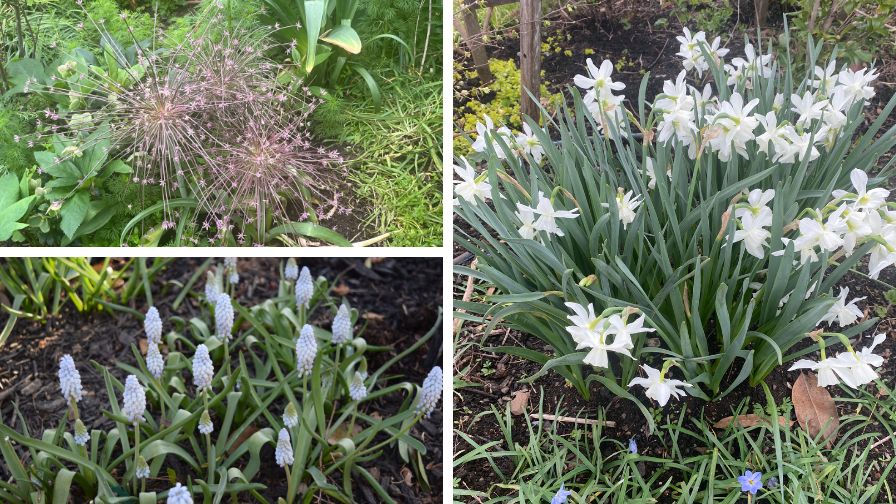
(Clockwise from Top Left) Ornamental onion, daffodils, and grape hyacinth flowers planted from pot of bulbs. | Allan Armitage
I recently spoke about plant diversity to a reasonably in tune gardener/landscape group as well as some IGCs (Independent Garden Centers). They were with me as I talked about perennials, shrubs, ferns, and annuals, furiously taking notes on those they had worked with or those they wished to improve upon. I was feeling rather good. I was engaging the audience well — until I started speaking about bulbs.
As my talk was on diversity, when I spoke about the big three (daffodils, tulips, and hyacinths), everyone nodded in agreement. But when I went on to the lesser-known bulbs, things began to unravel. The audience looked at me in confusion as I started with onions and were scratching their heads at my mention of rain lilies and spring star flowers. These old-fashioned plants were new to them, and the only place they may have seen them was in a bulb catalog or online.
So, I started slowly with emphasis on the IGC, asking them if they could bring pre-cooled potted bulbs to market. Dry bulbs in a bag are fine, I suppose, but hardly exciting to the consumer. But 10 fresh stems emerging from the soil simply invites people to look forward to the future. My go-to IGC, Grower’s Outlet in Loganville, GA, puts out hundreds of pots of budded daffodils, each promising guaranteed beauty in the landscape. They sell like hotcakes in early spring.

Flowers of daffodils, planted from lightly forced pot of 10 bulbs. | Allan Armitage
They also lightly force other lesser-known spring bulbs like crocus and grape hyacinths, but don’t limit themselves to spring. I picked up a number of pots of summer flowering ornamental onions, which, by the way, were also flying off the shelves. The promise of success is a powerful intoxicant.
Landscapers with big jobs have the labor to plant hundreds of dry bulbs at a time, but gardeners and smaller landscapers do not. Pre-cooled, ready-to-flower bulbs make sense for them. I have yet to see this concept at the box stores. Heaven help the IGC if they do this.
Here are a few other “minor” bulbs we need to get out in front of my audience. With a good photo, these have the potential to move well.
Grape Hyacinths, Muscari
Perhaps the easiest of all, and one that thrives in almost every landscape in the country.

Flowers of grape hyacinth, planted from lightly forced pot of 12 bulbs. | Allan Armitage
Spring Starflower, Ipheion
Perhaps the most difficult as so few people know these plants. However, they are also among the easiest to be successful with, flowering in the spring landscape.
Crocus
Everyone knows crocus; however, as forced bulbs they have a short shelf life. They will sell, but timing and marketing is essential for these.
Ornamental Onions, Allium
When my IGC markets their Giant onions and Tumbleweed onions, people line up. These bulbs are the definition of “Something to look forward to” — the mantra of anyone in the plant business.

Flowers of ornamental onion, planted from lightly forced pot of three bulbs. | Allan Armitage
Lilies
I understand the belief that a plant won’t sell unless it is in flower. Unfortunately, that belief, bad enough for almost any group of plants, is suicide for bulbs. Seeing forced lilies in pots is a turn-off. Everyone knows they will be flowered out within the week. Like ornamental onions, they possess the magic of the future and, when sold as lightly forced pots in the spring, will move quickly.
There were other bulbs I spoke about that evening such as Caladium, Lycoris, and species tulips. Dry, bagged bulbs are traditional, but today’s consumers look upon them as too much work. Success begets sales, and some of these lesser-known bulbs may do just that.

